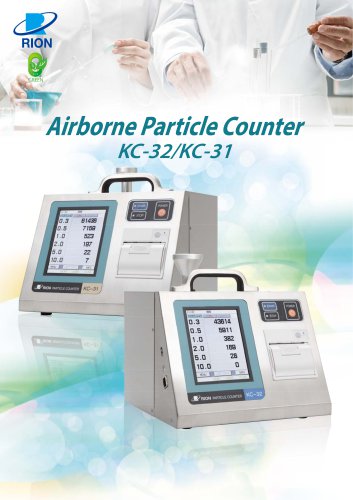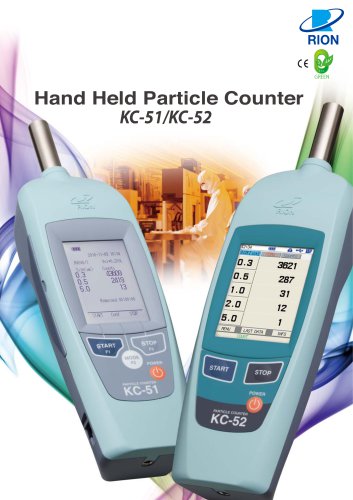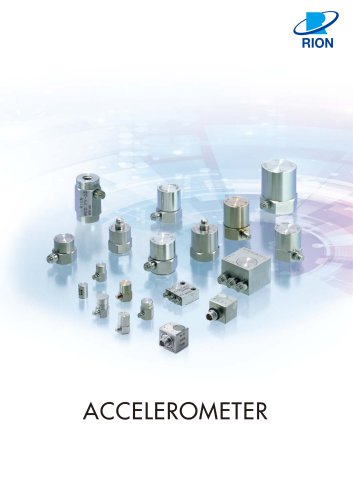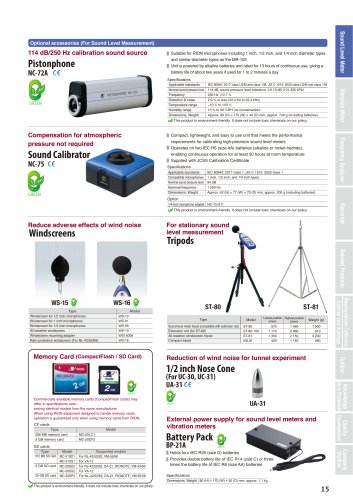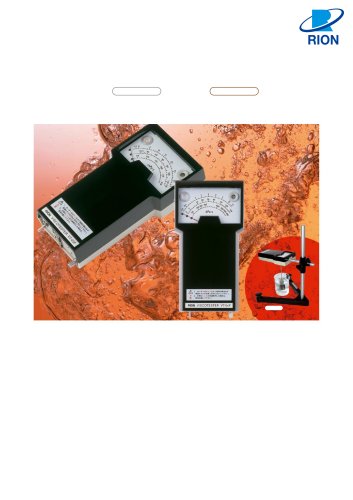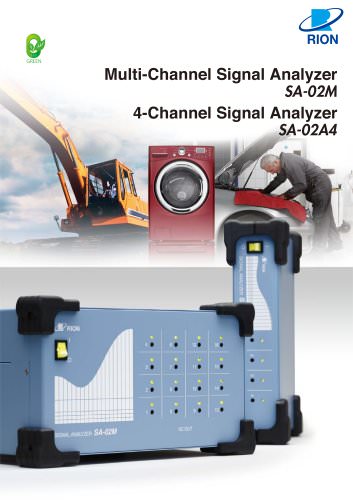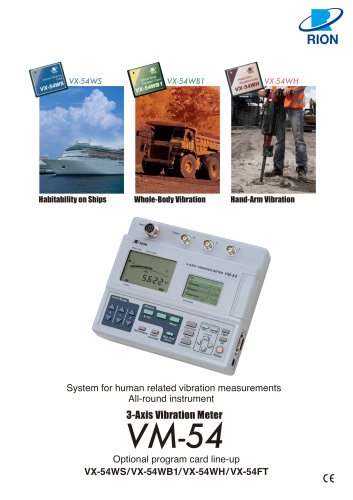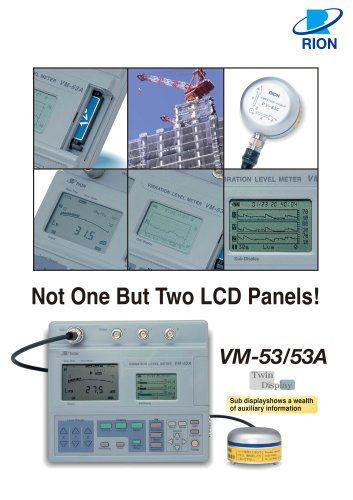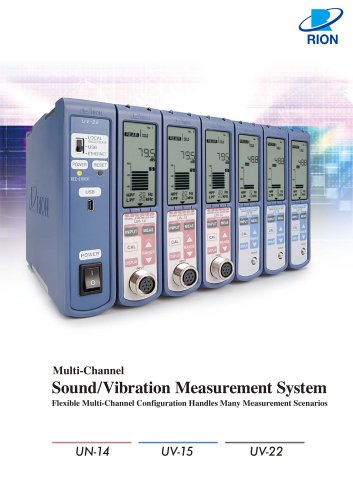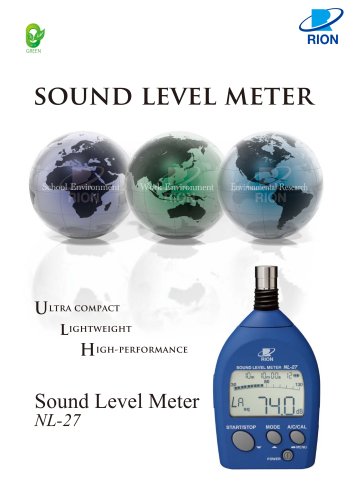 Website:
RION Co., Ltd
Website:
RION Co., Ltd
Catalog excerpts

Vibration Analyzer
Open the catalog to page 1
Portable vibration analyzer for Equipment Diagnosis and On-site Measurements Vibration Meter VA-12 With FFT analysis function rw.aan Utftdgqjnel Waning Piezoelectric Accelerometer Magnet attachment(supplied) Compact & Lightweight Vibration Analyzer Major Application Fields Vibration measurement at various stages of product development Pre-shipment testing, post-installation operation checks Startup testing after periodic maintenance and servicing Daily routine checks and monitoring of unusual vibration conditions Measurement of problem vibrations and detection of fault sources Product...
Open the catalog to page 2
Vibration Meter Mode Menu Mode The crisp color TFT display (240 x 320 dots) is easy to read, whether outdoors, indoors, or in a dark location. Allows simultaneous measurement of acceleration, velocity, displacement, and acceleration crest factor Vibration meter mode FFT Analyzer Mode Real-time analysis frequency 20 kHz Time waveform display and spectrum display with up to 3 200 spectral lines. Envelope processing also supported. Vibration waveform data recording function(10 seconds at analysis frequency 20 kHz) Data stored in WAVE file format on memory card (SD card). Timer controlled...
Open the catalog to page 3
Vibration Meter Mode Displacement / Acceleration / Velocity Simultaneous Measurement of Three Components Vibration explained Mechanical vibrations can be represented as a complex combination of a spring and weight, as shown in the illustration on the right. The basic physical quantities that define vibration are displacement, velocity, and acceleration. By measuring each of these values, the vibration condition can be assessed. Displacement explained Spring Weight The movement distance (travel) from a reference point is called displacement. For example, if a car travels a distance of 100...
Open the catalog to page 4
Vibration Meter Mode Applications Simple Diagnosis Vibration magnitude Measuring the magnitude of vibrations is a useful diagnostic technique for ascertaining that machinery is operating normally and checking for signs of possible problems. For example, when vibrations exceeding the reference value in the velocity range (up to 1 000 Hz) are detected, the presence of an imbalance, misalignment, or loosening condition can be suspected, whereas vibrations in the acceleration range (1 kHz to about 12 to 15 kHz) point to possible bearing or gear problems. Crest factor The crest factor (C.F.) is...
Open the catalog to page 5
FFT Analyzer Mode Motor The Need for Frequency Analysis Vibration amplitude Machinery usually comprises a variety of vibration sources such as motors, gears, bearings, fans, etc. When devising measures to minimize vibrations and when trying to locate the causes of problematic vibrations, measuring only the magnitude of vibrations often will not provide enough information. It is also necessary to perform frequency analysis, in order to determine which types of vibrations exist and what their levels are. As shown in the illustration, the locations where vibrations occur will affect the...
Open the catalog to page 6
FFT Analyzer Mode Applications Precision Diagnosis of Rotating Machinery Precision diagnosis is used to determine the cause of problems as well as the extent, location etc. Bearing problems will cause acceleration values. envelope analysis shows the peaks at equal intervals. When the size, number of rolling elements, axis rotation speed and other parameters peaks will provide information about the problem location. To measure the resolution frequency, the structure is struck with a hammer or similar and the resulting vibrations are subject to frequency analysis.
Open the catalog to page 7
Standard compliance Chinese RoHS (export model for China only; WEEE Directive BNC, CCLD 1 8 V 2 mA, (CCLD24 V 4 mA available as factory option) Piezoelectric Accelerometer PV-57I (supplied) At sensitivity 1.00 to 9.99 mV/(m/sg), using PV-57I Measurement rang V-57I, High-pass filter 3 Hz, Low-pass filter 20 kHz) ACC (Acceleration) 0.02 to 1 41.4 m/s2 (rms) Continuous measurement, 1 Hzto5kHz maximum acceleration DISP (Displacement) 0.02 to 40.0 mm (EQp-p) at 1 5.9 1 5 Hz Measurement frequency range (electrical characteristics) DISP (Displacement) Acceleration envelope cun/e High-pass filter...
Open the catalog to page 8All RION Co. catalogs and technical brochures
-
kC-20A
2 Pages
-
KC-22A
2 Pages
-
NA-42
4 Pages
-
TWS-01
2 Pages
-
Accelerometer PV Series
8 Pages
-
AS-60
4 Pages
-
Windscreen
1 Pages
-
NC-72A
2 Pages
-
VT-05
2 Pages
-
VT-03F
2 Pages
-
LR-07
2 Pages
-
DA-40
8 Pages
-
SA-78
4 Pages
-
SA-02A4
16 Pages
-
VM-83
4 Pages
-
VM-82
4 Pages
-
VM-63A
4 Pages
-
VM-54
8 Pages
-
VM-53
4 Pages
-
UV-16 Datasheet(0,60MB)
2 Pages
-
UN-14
4 Pages
-
NL-27 Datasheet
2 Pages
-
NA-28
6 Pages
-
NL-62?Sound Level Meter
8 Pages


